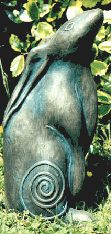
Image: Subject and photographer unknown.
 Write George Ewart Evans and David Thomson:
Write George Ewart Evans and David Thomson: In some societies it was not everybody’s soul that could enter an animal. Only the chosen – the wise elder or the child that was born to be a priest or shaman – possessed that power; they possessed it during their lives as well as after death. Like the witches they could shift their minds into paraphysical states, rendering themselves “beside themselves” as we say of people who have temporarily abandoned the controls of reason.
In some societies it was not everybody’s soul that could enter an animal. Only the chosen – the wise elder or the child that was born to be a priest or shaman – possessed that power; they possessed it during their lives as well as after death. Like the witches they could shift their minds into paraphysical states, rendering themselves “beside themselves” as we say of people who have temporarily abandoned the controls of reason.
 As "an embodiment of the mystery, danger and freedom of the music itself," writes Short, "the crotch has occupied a central role in a stirring rock performance."
As "an embodiment of the mystery, danger and freedom of the music itself," writes Short, "the crotch has occupied a central role in a stirring rock performance."Of course, the crotch today remains a valuable weapon in the rock arsenal, as exemplified by the current wave of tight pants bands rehashing the Kinks/The Who sound of the 60s and 70s. More and more women are also mobilizing their crotches as well for the good of the rock. Take Peaches, for example. In recent years, the famed Electroclash chanteuse has turned her crotch into something of a cottage industry for photos, song lyrics and album covers.
 Top of the list is Led Zepplin's Robert Plant, who elsewhere on the web is described as the "Definitive Bulge of Rock and Roll."
Top of the list is Led Zepplin's Robert Plant, who elsewhere on the web is described as the "Definitive Bulge of Rock and Roll." Bucks are very promiscuous and many may be attracted to a female prior to her being properly in season. A male will stay close to a doe, guarding her, until after mating has taken place. Several males will be drawn to the vicinity of the doe from different directions and there may be scuffles as the males are intent on trying their luck and keep harassing her.
Bucks are very promiscuous and many may be attracted to a female prior to her being properly in season. A male will stay close to a doe, guarding her, until after mating has taken place. Several males will be drawn to the vicinity of the doe from different directions and there may be scuffles as the males are intent on trying their luck and keep harassing her. Fighting, boxing, scratching and biting takes place and the fur often flies, but usually it is the doe who is the aggressor as she tries to fend off their unwanted attentions.
Fighting, boxing, scratching and biting takes place and the fur often flies, but usually it is the doe who is the aggressor as she tries to fend off their unwanted attentions.




NOTE: I've had reports of readers not being able to access this blog and/or pages of it because they get stuck on the “Sensitive Content” warning page which redirects back to itself every time they try to click through. I'm not sure what the issue is, though it might be a problem stemming from when the site shifted from http to https. Accordingly, it should be resolved when you add https:// to the front of the link for the page you are trying to access.